Valorization of Coffee Husk in Ternary Bio-Composites: Synergistic Reinforcement of Bio-Epoxy/Polylactic Acid for Enhanced Mechanical and Physical Properties
Abstract
1. Introduction
2. Materials and Methods
2.1. Materials and Preparation
2.2. Characterization Techniques
2.2.1. Characterization Techniques
2.2.2. Spectroscopic Analysis
2.2.3. Morphological Examination of Composites and Fillers
2.2.4. Rheological Characterization
2.2.5. Mechanical Characterization
2.2.6. Statistical Analysis
3. Results
4. Conclusions
Author Contributions
Funding
Institutional Review Board Statement
Data Availability Statement
Acknowledgments
Conflicts of Interest
References
- Khan, A.; Sapuan, S.M.; Yusuf, J.; Siddiqui, V.U.; Zainudin, E.S.; Zuhri, M.Y.M.; Tuah Baharuddin, B.T.H.; Ansari, M.A.; Rahman, A.A.A. An examination of cutting-edge developments in Bamboo-PLA composite research: A comprehensive review. Renew. Sustain. Energy Rev. 2023, 188, 113832. [Google Scholar] [CrossRef]
- Nuilek, K.; Somdee, P.; Chumsamrong, P.; Singsang, W.; Sittitanadol, I.; Prasoetsopha, N. Sustainable bio-reinforcing mangosteen peel biochar filler in styrene-butadiene rubber: Analysis of thermal, physical, mechanical, and dielectric properties. Polym. Compos. 2025, 46, S242–S253. [Google Scholar] [CrossRef]
- Qasim, U.; Fatima, R.; Usman, M. Efficient barrier properties of mechanically enhanced agro-extracted cellulosic biocomposites. Mater. Today Chem. 2020, 18, 100378. [Google Scholar] [CrossRef]
- Verma, D.; Fortunati, E. Biopolymer processing and its composites: An introduction. In Biomass, Biopolymer-Based Materials, and Bioenergy: Construction, Biomedical, and Other Industrial Applications; Elsevier: Amsterdam, The Netherlands, 2019; pp. 3–23. [Google Scholar] [CrossRef]
- David, N.V.; Rum, S.S.M. Eco-biocomposite materials for shock cushioning application: An outlook of the potentials and challenges. J. Teknol. 2015, 76, 79–84. [Google Scholar] [CrossRef]
- Qian, Z.; Peng, Z. Reinforcing styrene-butadiene rubber composites by constructing multiple interactions between rubber and silica. Polym. Compos. 2019, 40, 1740–1747. [Google Scholar] [CrossRef]
- Moreno-Miranda, C.; Dries, L. Integrating coordination mechanisms in sustainability assessment of agri-food supply chains: From a structured literature review to a comprehensive framework. Ecol. Econ. 2022, 192, 107265. [Google Scholar] [CrossRef]
- Moreno-Miranda, C.; Dries, L. The Role of Coordination Mechanisms and Transaction Costs Promoting Sustainability Performance in Agri-Food Supply Chains: Evidence from Ecuador. Agribus. Int. J. 2024, 1–24. [Google Scholar] [CrossRef]
- Moreno-Miranda, C.; Dries, L. Circular economy intentions in the fruit and vegetable sector of Central Ecuador. Ecol. Econ. 2024, 219, 108056. [Google Scholar] [CrossRef]
- Syduzzaman, M.; Sultana Rumi, S.; Faiza Fahmi, F.; Akter, M.; Begum Dina, R. Mapping the recent advancements in bast fiber reinforced biocomposites: A review on fiber modifications, mechanical properties, and their applications. Results Mater. 2023, 20, 100448. [Google Scholar] [CrossRef]
- Arif, Z.U.; Khalid, M.Y.; Sheikh, M.F.; Zolfagharian, A.; Bodaghi, M. Biopolymeric sustainable materials and their emerging applications. J. Environ. Chem. Eng. 2022, 10, 108159. [Google Scholar] [CrossRef]
- Elgamsy, R.; Allah Abo Elmagd, A.; Elrahman Mokhtar, A.; Khalid, I.; Taha, N.; Sadek, S.; Tawfic, M.L.; Attia, T.; Elsabbagh, A. Developing fire retardant composites of biodegradable polyethylene reinforced with agricultural wastes. Ain Shams Eng. J. 2022, 13, 101768. [Google Scholar] [CrossRef]
- Kilani, A.; Olubambi, A.; Ikotun, B.; Adeleke, O.; Adetayo, O. Structural performance of concrete reinforced with banana and orange peel fibers—A review. J. Sustain. Constr. Mater. Technol. 2022, 7, 339–357. [Google Scholar] [CrossRef]
- Srubar, W.V.; Billington, S.L. Engineered biobased composites for construction: Material development, multiscale modeling, and long-term durability. In Structures Congress 2011, Proceedings of the 2011 Structures Congress, Las Vegas, NV, USA, 14–16 April 2011; The Structural Engineering Institute of ASCE: Boston, MA, USA, 2011; pp. 1147–1156. [Google Scholar] [CrossRef]
- Bianchini Silva, M.; Costa, U.O.; Mattoso, L.H.C.; Monteiro, S.N.; de Souza, M.L.; Vitorazi, L. Magnetic Nanoparticles in Biopolymer Fibers: Fabrication Techniques and Characterization Methods. Polymers 2024, 16, 2805. [Google Scholar] [CrossRef]
- Rahman, M.M.; Maniruzzaman, M.; Zaman, M.N. Fabrication and characterization of environmentally friendly biopolymeric nanocomposite films from cellulose nanocrystal of banana M. oranta (Sagar kala) tree rachis fibers and poly lactic acid: A new route. S. Afr. J. Chem. Eng. 2024, 50, 451–465. [Google Scholar] [CrossRef]
- Adamu, M.; Ibrahim, Y.E.; Alanazi, H. Evaluating the Influence of Elevated Temperature on Compressive Strength of Date-Palm-Fiber-Reinforced Concrete Using Response Surface Methodology. Materials 2022, 15, 8129. [Google Scholar] [CrossRef] [PubMed]
- Muhammed, A.P.; Thangarasu, S.; Oh, T.H. Green interconnected network structure of chitosan-microcrystalline cellulose-lignin biopolymer film for active packaging applications. Int. J. Biol. Macromol. 2023, 253, 127471. [Google Scholar] [CrossRef]
- Feng, Q.; Wang, L.; Wan, Z.; Bu, X.; Deng, Q.; Li, D.; Chen, C.; Xu, Z. Efficient ultraviolet blocking film on the lignin-rich lignocellulosic nanofibril from bamboo. Int. J. Biol. Macromol. 2023, 250, 126059. [Google Scholar] [CrossRef]
- Wang, J.; Sun, P.; Huang, Z. Cellulosic paper-based composites enhanced with long-chain fatty acids: Superb mechanical properties and water resistance. Polym. Compos. 2025, 46, S113–S123. [Google Scholar] [CrossRef]
- Aghaei, F.; Tangestaninejad, S.; Bahadori, M.; Moghadam, M.; Mirkhani, V.; Mohammadpoor−Baltork, I.; Khalaji, M.; Asadi, V. Green synthesize of nano-MOF-ethylcellulose composite fibers for efficient adsorption of Congo red from water. J. Colloid Interface Sci. 2023, 648, 78–89. [Google Scholar] [CrossRef] [PubMed]
- Raghav, G.R.; Nagarajan, K.J.; Palaninatharaja, M.; Karthic, M.; kumar, R.A.; Ganesh, M.A. Reuse of used paper egg carton boxes as a source to produce hybrid AgNPs- carboxyl nanocellulose through bio-synthesis and its application in active food packaging. Int. J. Biol. Macromol. 2023, 249, 126119. [Google Scholar] [CrossRef]
- Zhao, L.; Mao, Z.; Xu, H.; Wang, B.; Zhong, Y.; Ji, B.; Feng, X. Preparation of epoxy resin adhesives based on high phenolic nanomodified lignin particles. Int. J. Biol. Macromol. 2025, 309, 142886. [Google Scholar] [CrossRef]
- Du, Y.; Wang, R.; Meng, Q.; Zhang, X.; Xu, R. Bio-Based Epoxy-Phthalonitrile Resin: Preparation, Characterization, and Properties. Molecules 2024, 29, 5019. [Google Scholar] [CrossRef]
- Yang, X.; Shi, X.; Li, L.; Yuan, B.; Yu, F. Synthesis of polyrosin-based epoxy resins catalyzed by Lewis-acidic deep eutectic solvents. New J. Chem. 2025, 49, 7785–7793. [Google Scholar] [CrossRef]
- Sangaletti, D.; Ceseracciu, L.; Marini, L.; Athanassiou, A.; Zych, A. Biobased boronic ester vitrimer resin from epoxidized linseed oil for recyclable carbon fiber composites. Resour. Conserv. Recycl. 2023, 198, 107205. [Google Scholar] [CrossRef]
- Lascano, D.; Valcárcel, J.; Balart, R.; Quiles-Carrillo, L.; Boronat, T. Manufacturing of composite materials with high environmental efficiency using epoxy resin of renewable origin and permeable light cores for vacuum-assisted infusion molding. Ingenius 2020, 2020, 62–73. [Google Scholar] [CrossRef]
- Masssijaya, S.Y.; Lubis, M.A.R.; Nissa, R.C.; Nurhamiyah, Y.; Nugroho, P.; Antov, P.; Lee, S.H.; Papadopoulos, A.N.; Kusumah, S.S.; Karlinasari, L. Utilization of Spent Coffee Grounds as a Sustainable Resource for the Synthesis of Bioplastic Composites with Polylactic Acid, Starch, and Sucrose. J. Compos. Sci. 2023, 7, 512. [Google Scholar] [CrossRef]
- Souri Rudabadi, M.; Ashenai Ghasemi, F.; Fasihi, M.; Rajaee, P. An experimental study on the microstructural, tensile, and fracture properties of biodegradable polylactic acid blended with thermoplastic corn starch filled with halloysite nanotubes. Ind. Crops Prod. 2023, 201, 116922. [Google Scholar] [CrossRef]
- Aydogdu Emir, A.; Akgun, M.; Kirtil, E. Effect of mastic gum integration on improvement of polylactic acid biodegradable films. Polym. Eng. Sci. 2023, 63, 1539–1550. [Google Scholar] [CrossRef]
- Pycka, S.; Roman, K. Comparison of Wood-Based Biocomposites with Polylactic Acid (PLA) Density Profiles by Desaturation and X-ray Spectrum Methods. Materials 2023, 16, 5729. [Google Scholar] [CrossRef] [PubMed]
- Hennessey-Ramos, L.; Murillo-Arango, W.; Vasco-Correa, J.; Astudillo, I.C.P. Enzymatic extraction and characterization of pectin from cocoa pod husks (Theobroma cacao L.) using celluclast® 1. 5 L. Molecules 2021, 26, 1473. [Google Scholar] [CrossRef]
- Intriago, B.; Orejuela, L.; Sosa, G.; Guerra, I.; Brito, A. Biobased Films Using Ecuadorian Agro-industrial Residues—In the Framework of a Circular Bioeconomy, Circular Engineering, and Sustainability. In Proceedings of the AIChE Annual Meeting, San Diego, CA, USA, 27–31 October 2024; Available online: https://www.scopus.com/pages/publications/105003710367 (accessed on 15 May 2025).
- Hernández-Domínguez, E.; Espinosa-Solís, V.; Hernández-Nava, R.G.; García-Barrientos, R.; Suárez-Rodríguez, C.d.P.; Gallardo-Bernal, P.; Figueroa-Wences, V.M.; Sánchez-Mundo, M.d.l.L. Valorization of Cocoa Bean Shell Agro-Industrial Residues for Producing Functional Hot Water Infusions. Processes 2024, 12, 2905. [Google Scholar] [CrossRef]
- ASTM D638-10; Standard Test Method for Tensile Properties of Plastics. ASTM International: Conshohocken, PA, USA, 2010. [CrossRef]
- Barón, E.J.R.; Zarate, D.A.; Castañeda, G.A.A.; Cuarán, V.L.; Passarelli, L.M. Micromorphology and ultrastructure of anthers and pollen grains in ten elite genotypes of Theobroma cacao (Malvaceae). Rev. Biol. Trop. 2021, 69, 403–421. [Google Scholar] [CrossRef]
- Zambrano-Mite, L.F.; Villasana, Y.; Bejarano, M.L.; Luciani, C.; Niebieskikwiat, D.; Álvarez, W.; Cueva, D.F.; Aguilera-Pesantes, D.; Orejuela-Escobar, L.M. Optimization of microfibrillated cellulose isolation from coffee pod husk via mild oxalic acid hydrolysis: A response surface methodology approach. Heliyon 2023, 9, e17258. [Google Scholar] [CrossRef]
- Mirkhalaf, S.M.; Fagerström, M. The mechanical behavior of polylactic acid (PLA) films: Fabrication, experiments and modelling. Mech. Time-Depend. Mater. 2021, 25, 119–131. [Google Scholar] [CrossRef]
- Valladares-Diestra, K.K.; Porto de Souza Vandenberghe, L.; Nishida, V.S.; Soccol, C.R. The potential of imidazole as a new solvent in the pretreatment of agro-industrial lignocellulosic biomass. Bioresour. Technol. 2023, 372, 128666. [Google Scholar] [CrossRef]
- Vidal, J.; Ponce, D.; Mija, A.; Rymarczyk, M.; Castell, P. Sustainable Composites from Nature to Construction: Hemp and Linseed Reinforced Biocomposites Based on Bio-Based Epoxy Resins. Materials 2023, 16, 1283. [Google Scholar] [CrossRef] [PubMed]
- Tremeac, B.; Hayert, M.; Le-Bail, A. Mechanical properties of Tylose gel and chocolate in the freezing range. Int. J. Refrig. 2008, 31, 867–873. [Google Scholar] [CrossRef]
- Murugan, G.; Benjakul, S.; Prodpran, T.; Rajasekaran, B.; Baboonsundaram, A.; Nagarajan, M. Enhancement of Barrier Properties of Fish Skin Gelatin Based Film Layered with PLA and PBAT. J. Polym. Environ. 2023, 31, 5416–5431. [Google Scholar] [CrossRef]
- Salmins, M.; Gortner, F.; Mitschang, P. Challenges in Manufacturing of Hemp Fiber-Reinforced Organo Sheets with a Recycled PLA Matrix. Polymers 2023, 15, 4357. [Google Scholar] [CrossRef]
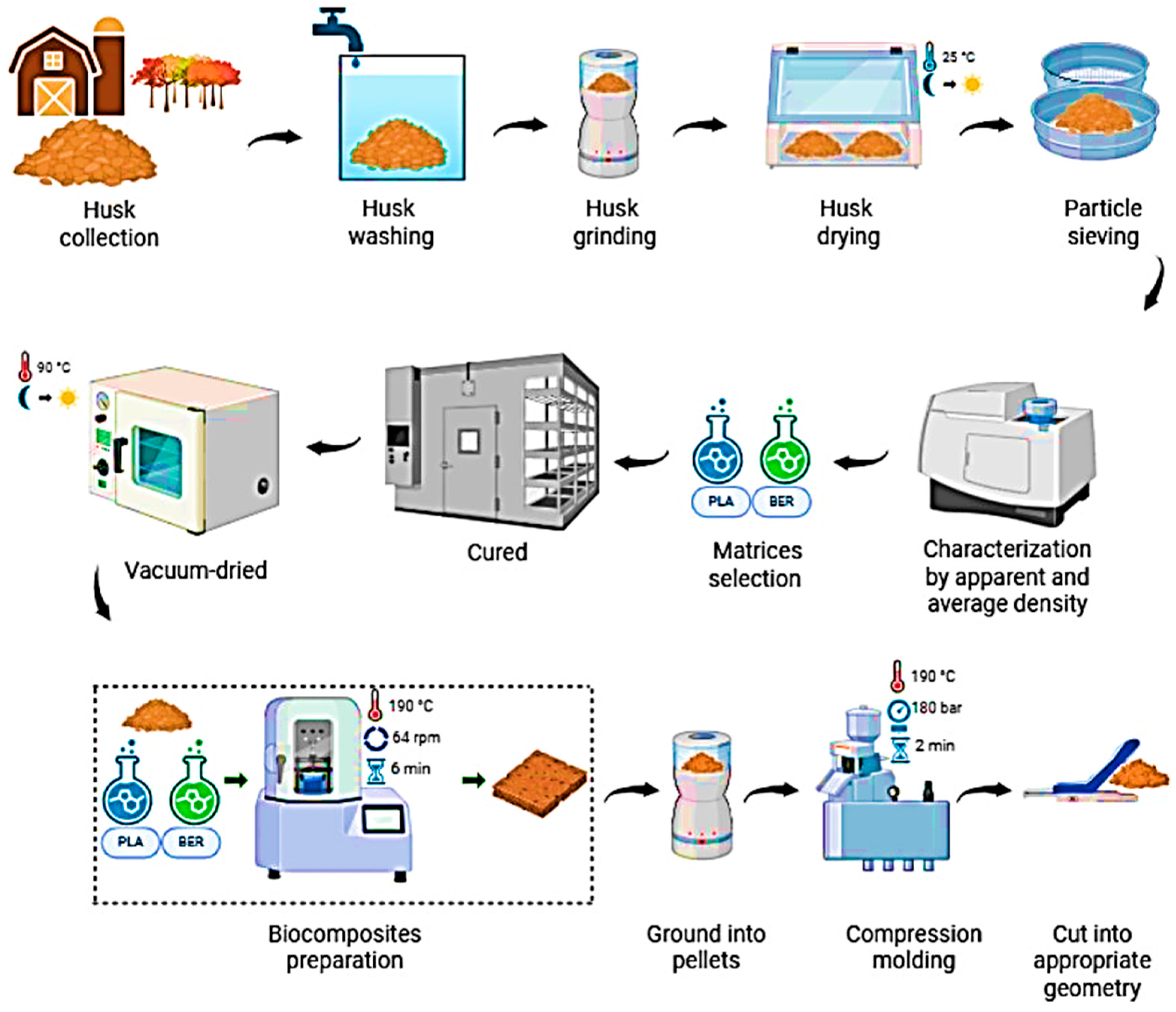


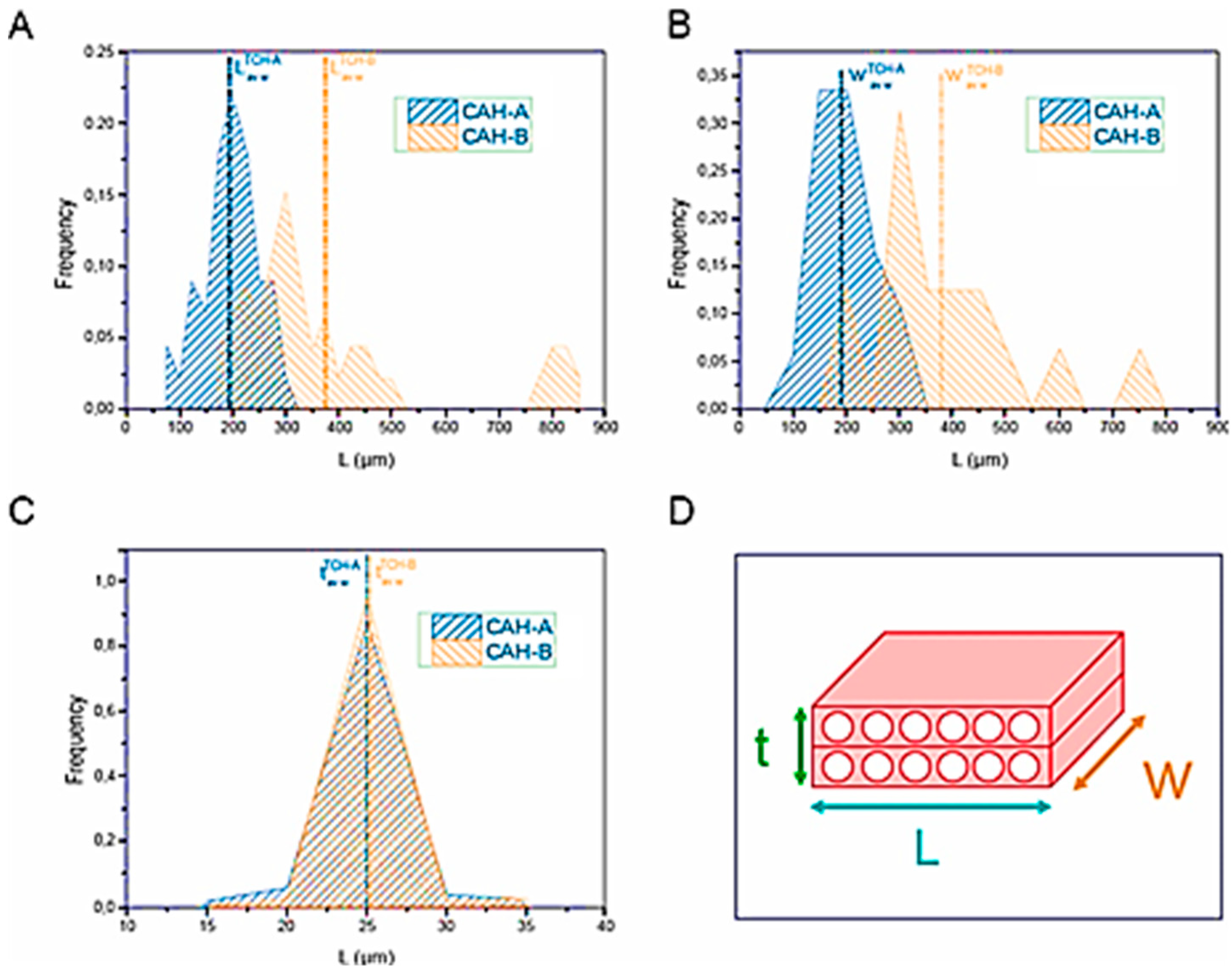

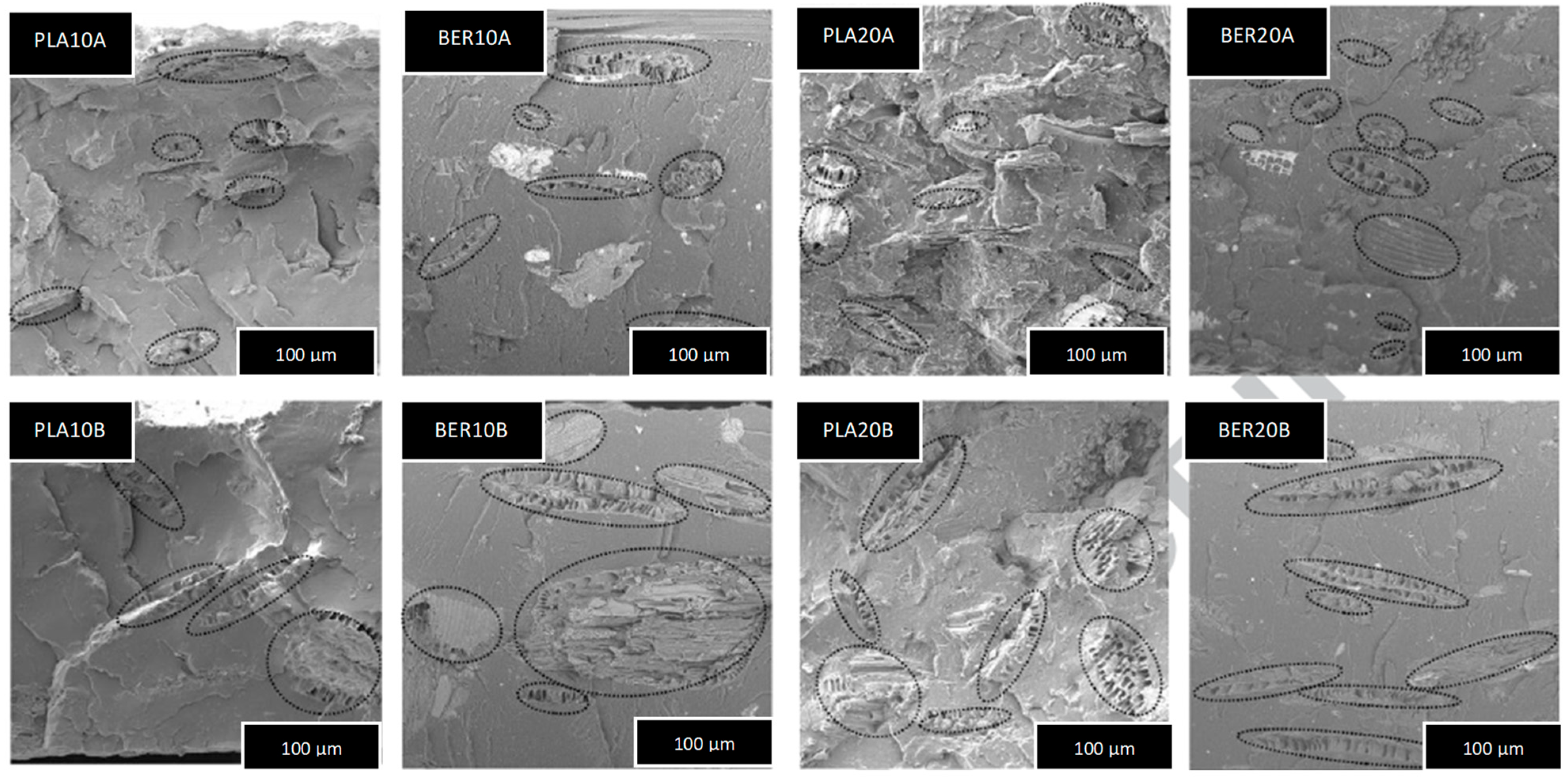
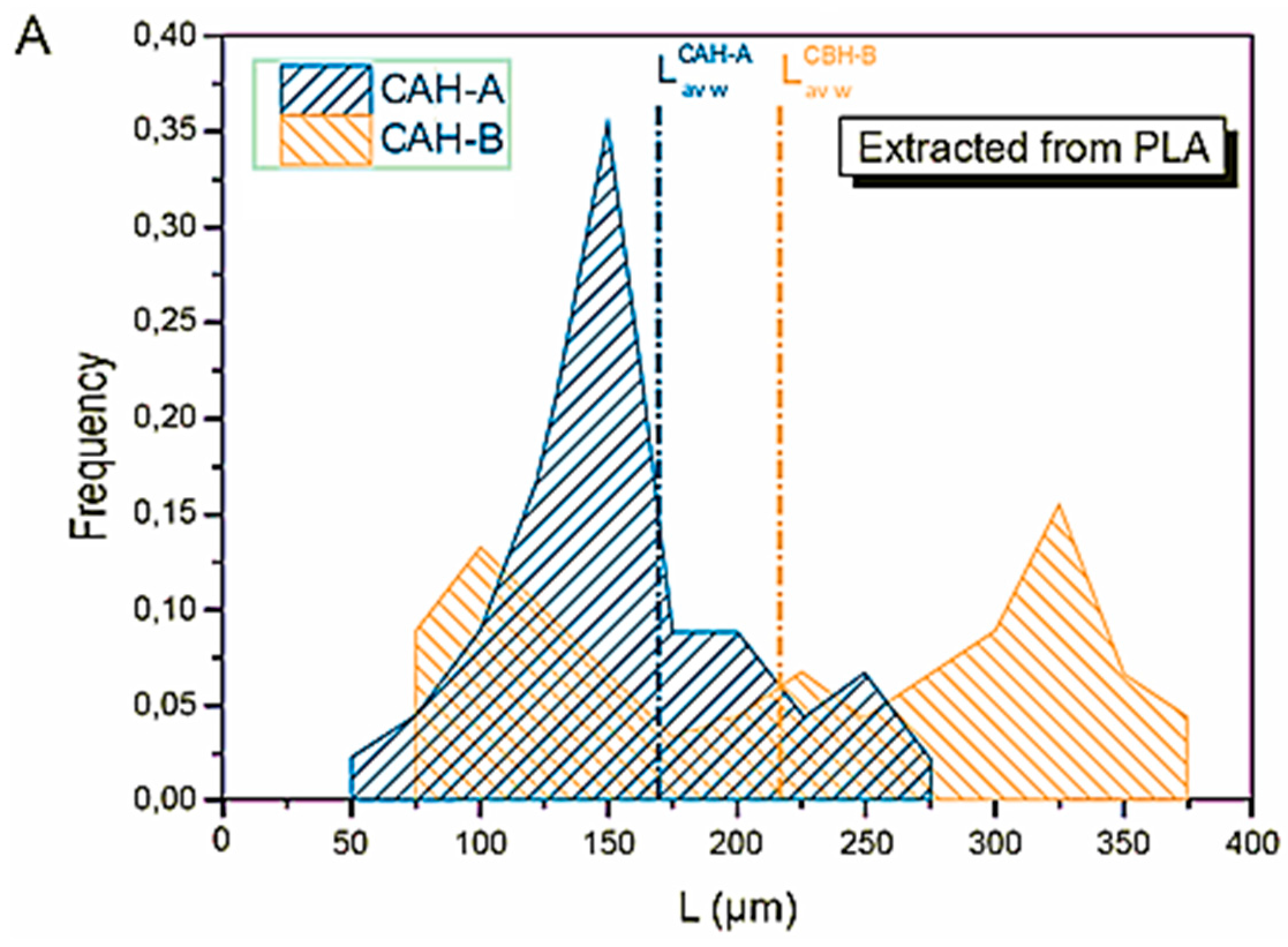



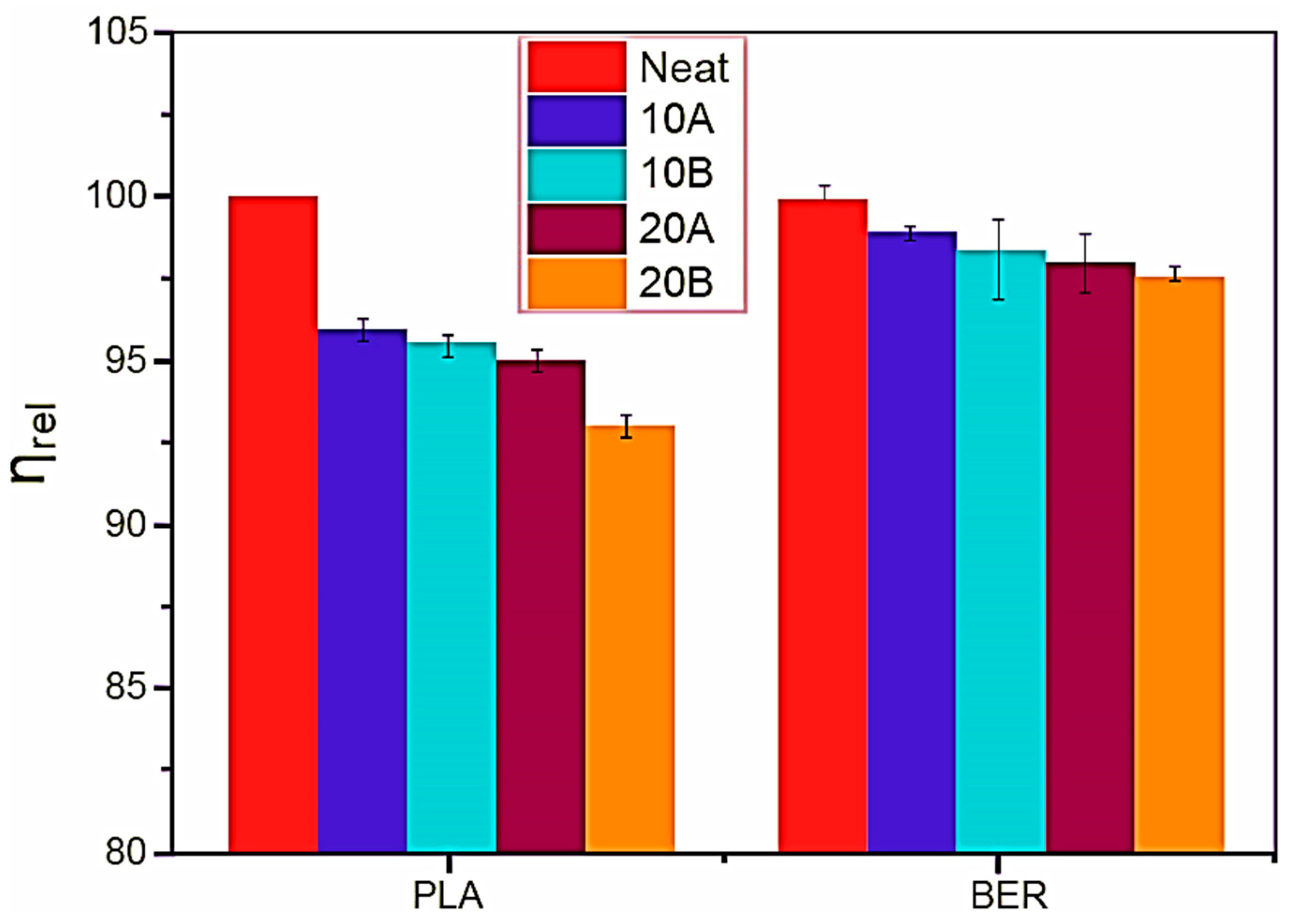

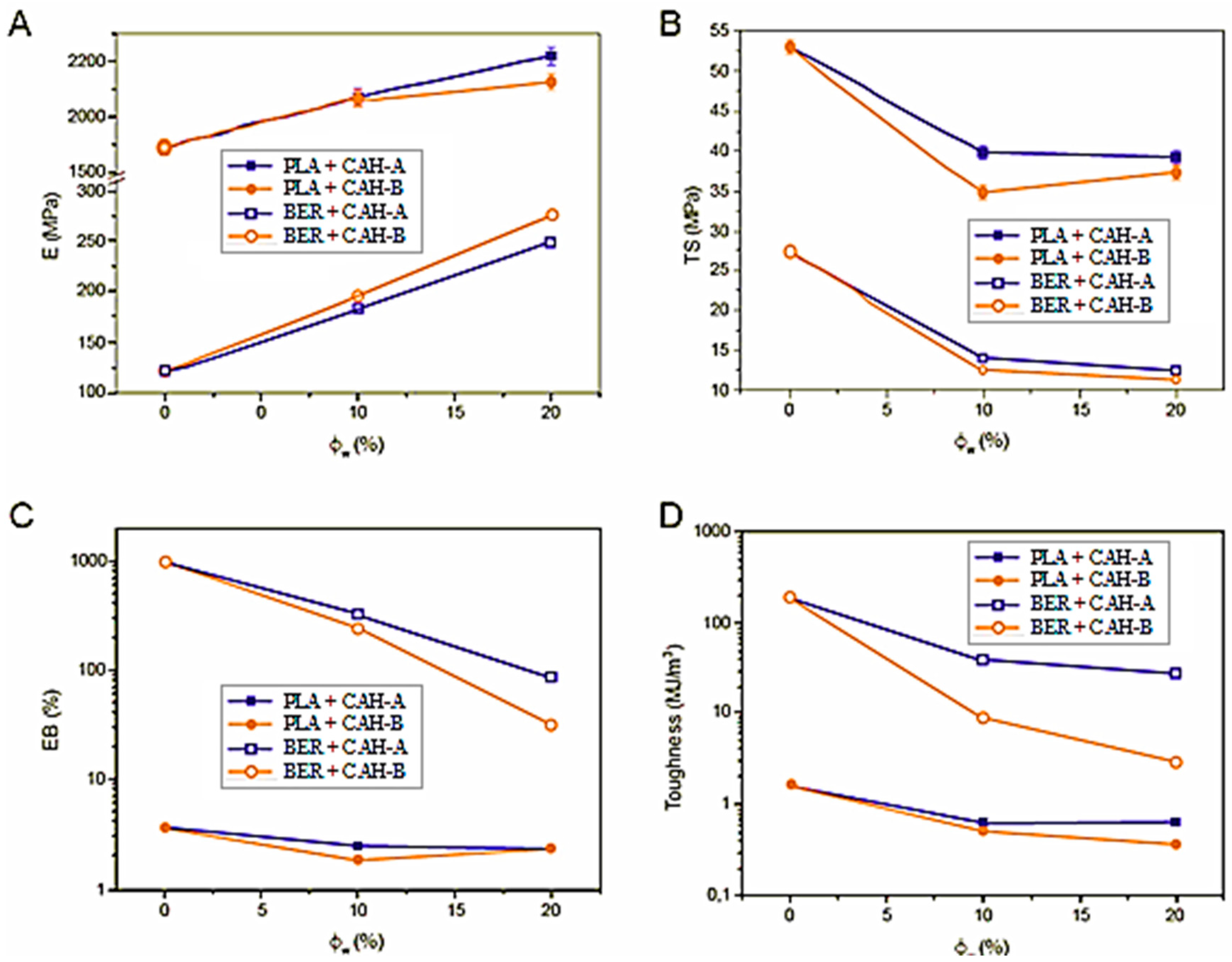
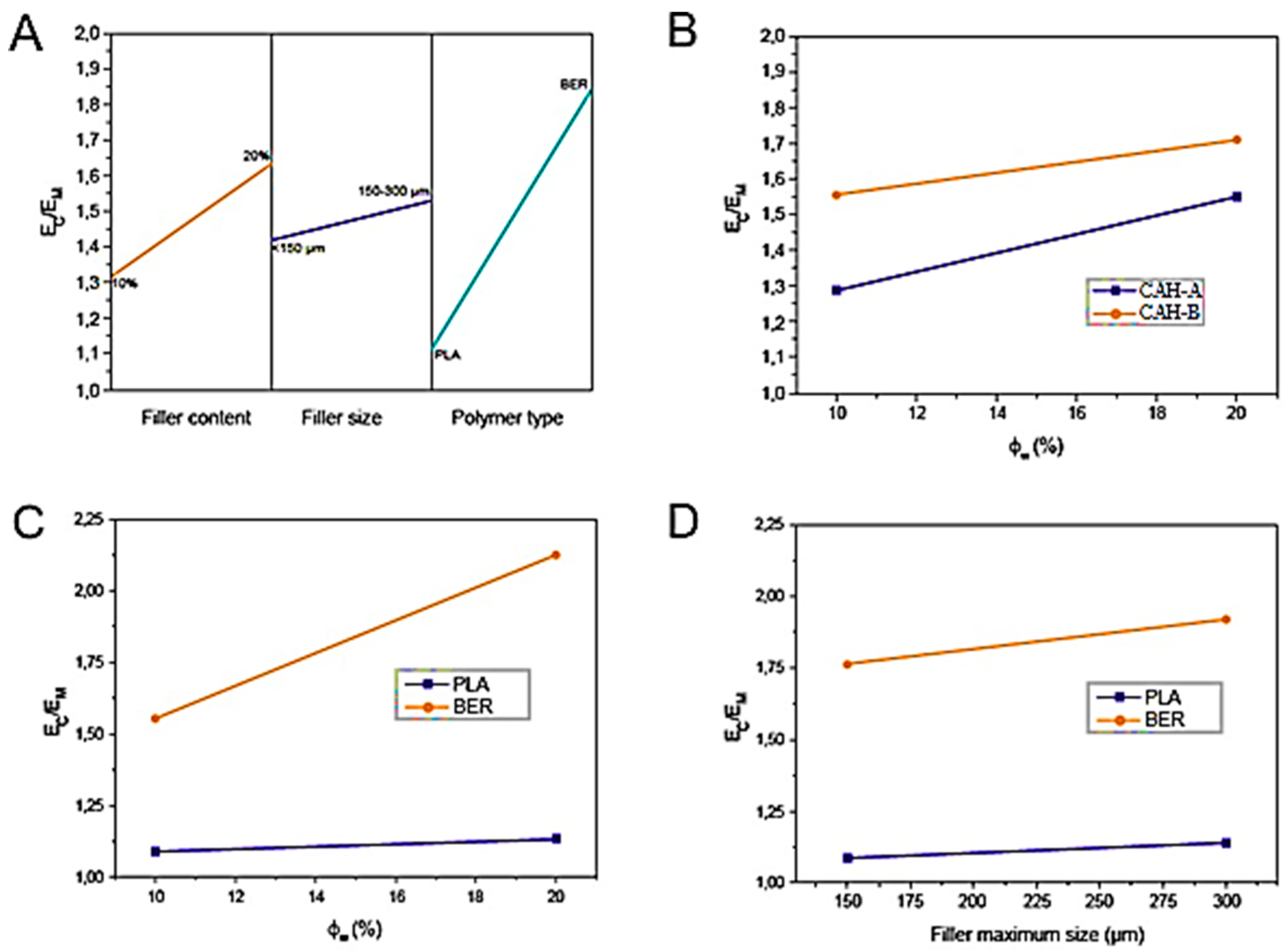

| Sample | Density (g/cm3) | MFI (g/10 min) | Tm (°C) | Molecular Weight (Da) |
|---|---|---|---|---|
| LA | 1.3 | 6 | 149 | Mn = 112,990 |
| BER | 1.2 | ~8 | ≈90 | Mn = 8000 |
| Reference Symbol | Polymeric Media | CAH Proportion (wt %) | CAH Particle Granularity (μm) |
|---|---|---|---|
| LA | LA2002D | - | |
| LA10A | LA2002D | 15 | 74–149 |
| LA20A | LA2002D | 30 | 74–149 |
| LA10B | LA2002D | 15 | 149–299 |
| LA20B | LA2002D | 30 | 149–299 |
| BER | BER170G | - | |
| BER10A | BER170G | 15 | 74–149 |
| BER20A | BER170G | 30 | 74–149 |
| BER10B | BER170G | 15 | 149–299 |
| BER20B | BER170G | 30 | 149–299 |
| CAHs Category | |||||
|---|---|---|---|---|---|
| A | 196.2 | 99.6 | 26 | 154.8 | 7.1 |
| B | 375.2 | 198.5 | 26 | 311.7 | 13.3 |
| Experimental Runs | 1 | 2 | 3 | Data Dispersion | ||
|---|---|---|---|---|---|---|
| % CAH | CAH Particle Dimension | Polymer Dimension | Min | Max | Mean | |
| LA10A | − | − | − | 1.051 | 1.137 | 1.087 |
| LA20A | + | − | − | 1.053 | 1.131 | 1.092 |
| LA10B | − | + | − | 1.072 | 1.123 | 1.097 |
| LA20B | + | + | − | 1.134 | 1.235 | 1.188 |
| BER10A | − | − | + | 1.517 | 1.501 | 1.506 |
| BER20A | + | − | + | 1.986 | 2.058 | 2.023 |
| BER10B | − | + | + | 1.614 | 1.611 | 1.605 |
| BER20B | + | + | + | 2.238 | 2.242 | 2.240 |
| V(E) | 0.0003 | |||||
| SE | 0.019 | |||||
| Significance threshold | 0.044 | |||||
| Experimental Runs | Main Effects | Binary Interactions | Ec/Ew | ||||
|---|---|---|---|---|---|---|---|
| 1 | 2 | 3 | 1–2 | 1–3 | 2–3 | ||
| LA10A | − | − | − | + | + | + | 1.086 |
| LA20A | + | − | − | − | − | + | 1.089 |
| LA10B | − | + | − | − | + | − | 1.095 |
| LA20B | + | + | − | + | − | − | 1.185 |
| BER10A | − | − | + | + | − | − | 1.499 |
| BER20A | + | − | + | − | + | − | 2.021 |
| BER10B | − | + | + | − | − | + | 1.604 |
| BER20B | + | + | + | + | + | + | 2.238 |
| 0.311 | 0.106 | 0.726 | 0.108 | 0.265 | 0.054 | 1.477 | |
| Experimental Runs | 1 | 2 | 3 | Data Scattering | ||
|---|---|---|---|---|---|---|
| % CAH | CAH Size | Polymer Size | Min | Max | Mean | |
| LA10A | − | − | − | 0.37041 | 0.37924 | 0.37482 |
| LA20A | + | − | − | 0.29968 | 0.31257 | 0.30612 |
| LA10B | − | + | − | 0.36553 | 0.38553 | 0.37553 |
| LA20B | + | + | − | 0.21908 | 0.22075 | 0.21992 |
| BER10A | − | − | + | 0.20658 | 0.21588 | 0.21123 |
| BER20A | + | − | + | 0.04694 | 0.04905 | 0.04800 |
| BER10B | − | + | + | 0.14690 | 0.15350 | 0.15020 |
| BER20B | + | + | + | 0.01507 | 0.01575 | 0.01541 |
| V(E) | 9.778 × 10−6 | |||||
| SE | 0.00312 | |||||
| Significance threshold | 0.00719 | |||||
| Experimental Runs | Main Effects | Binary Interactions | Dimensionless Toughness | ||||
|---|---|---|---|---|---|---|---|
| 1 | 2 | 3 | 1–2 | 1–3 | 2–3 | ||
| LA10A | − | − | − | + | + | + | 0.37482 |
| LA20A | + | − | − | − | − | + | 0.30612 |
| LA10B | − | + | − | − | + | − | 0.37553 |
| LA20B | + | + | − | + | − | − | 0.21992 |
| BER10A | − | − | + | + | − | − | 0.21123 |
| BER20A | + | − | + | − | + | − | 0.04800 |
| BER10B | − | + | + | − | − | + | 0.15020 |
| BER20B | + | + | + | + | + | + | 0.01541 |
| −0.13058 | −0.04477 | −0.21288 | −0.01911 | −0.01844 | −0.00201 | 0.21265 | |
Disclaimer/Publisher’s Note: The statements, opinions and data contained in all publications are solely those of the individual author(s) and contributor(s) and not of MDPI and/or the editor(s). MDPI and/or the editor(s) disclaim responsibility for any injury to people or property resulting from any ideas, methods, instructions or products referred to in the content. |
© 2025 by the authors. Licensee MDPI, Basel, Switzerland. This article is an open access article distributed under the terms and conditions of the Creative Commons Attribution (CC BY) license (https://creativecommons.org/licenses/by/4.0/).
Share and Cite
Molina-Sánchez, I.; Moreno-Miranda, C.; Peñafiel, R.; Paredes-Escobar, M.; Pazmiño-Miranda, P.; Aldás, M.; Altamirano-Freire, E.; Flores, N. Valorization of Coffee Husk in Ternary Bio-Composites: Synergistic Reinforcement of Bio-Epoxy/Polylactic Acid for Enhanced Mechanical and Physical Properties. Polymers 2025, 17, 3013. https://doi.org/10.3390/polym17223013
Molina-Sánchez I, Moreno-Miranda C, Peñafiel R, Paredes-Escobar M, Pazmiño-Miranda P, Aldás M, Altamirano-Freire E, Flores N. Valorization of Coffee Husk in Ternary Bio-Composites: Synergistic Reinforcement of Bio-Epoxy/Polylactic Acid for Enhanced Mechanical and Physical Properties. Polymers. 2025; 17(22):3013. https://doi.org/10.3390/polym17223013
Chicago/Turabian StyleMolina-Sánchez, Isaác, Carlos Moreno-Miranda, Rodny Peñafiel, Mayra Paredes-Escobar, Pilar Pazmiño-Miranda, Miguel Aldás, Estefanía Altamirano-Freire, and Nelly Flores. 2025. "Valorization of Coffee Husk in Ternary Bio-Composites: Synergistic Reinforcement of Bio-Epoxy/Polylactic Acid for Enhanced Mechanical and Physical Properties" Polymers 17, no. 22: 3013. https://doi.org/10.3390/polym17223013
APA StyleMolina-Sánchez, I., Moreno-Miranda, C., Peñafiel, R., Paredes-Escobar, M., Pazmiño-Miranda, P., Aldás, M., Altamirano-Freire, E., & Flores, N. (2025). Valorization of Coffee Husk in Ternary Bio-Composites: Synergistic Reinforcement of Bio-Epoxy/Polylactic Acid for Enhanced Mechanical and Physical Properties. Polymers, 17(22), 3013. https://doi.org/10.3390/polym17223013







